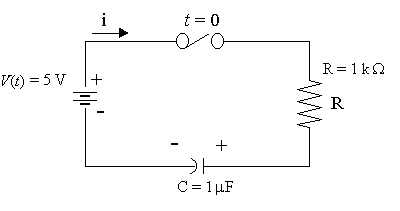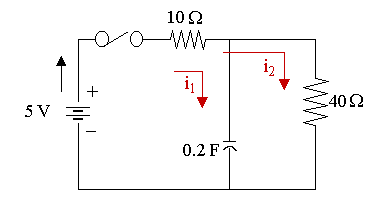Circuit Equations
There are two (related) approaches:- Derive the circuit (differential) equations in the time domain, then transform these ODEs to the s-domain;
- Transform the circuit to the s-domain, then derive the circuit equations in the s-domain (using the concept of "impedance").
EXAMPLE 1
Consider the circuit when the switch is closed at t = 0 with VC(0) = 1.0 V. Solve for the current i(t) in the circuit.
Multiplying throughout by 10−6:

Taking Laplace transform:

Now in this example, we are told
So

That is:
NOTE:

Collecting I terms and subtracting

Finding the inverse Laplace transform gives us

Note: Throughout this page these problems are also solved using Scientific Notebook. They are TEX files and you need Scientific Notebook or similar, to view them.
Alternative answer using Scientific Notebook. (.tex file) 
EXAMPLE 2
Solve for i(t) for the circuit, given that V(t) = 10 sin5t V, R = 4 W and L = 2 H.

So
25 = A(s2 + 25) + (Bs + C)(s + 2)
We need to solve for A, B and C.
First, let s = −2 and this gives
25 = 29A
Thus A = 25/29
Next, we equate coefficients of s2:
Equating coefficients of
So

So we have

Alternative answer using Scientific Notebook. (.tex file) 
EXAMPLE 3
In the circuit shown below, the capacitor is uncharged at time t = 0. If the switch is then closed, find the currents i1 and i2, and the charge on C at time t greater than zero.NOTE: We could either:
For the first loop, we have:

For the second loop, we have:

Substituting (2) into (1) gives:

Next we take the Laplace Transform of both sides.
Note:

In this example, . So
. So 

Now taking Inverse Laplace:

And using result (2) from above, we have:

For charge on the capacitor, we first need voltage across the capacitor:

So, since , we have:
, we have:

Graph of q(t):

- Set up the equations, take Laplace of each, then solve simultaneously
- Set up the equations, solve simultaneously, then take Laplace.
For the first loop, we have:

For the second loop, we have:

Substituting (2) into (1) gives:

Next we take the Laplace Transform of both sides.
Note:

In this example,

Now taking Inverse Laplace:
And using result (2) from above, we have:

For charge on the capacitor, we first need voltage across the capacitor:

So, since

Graph of q(t):

EXAMPLE 4
In the circuit shown, the capacitor has an initial charge of 1 mC and the switch is in position 1 long enough to establish the steady state. The switch is moved from position 1 to 2 at t = 0. Obtain the transient current i(t) for t > 0. Position 1, after a `long time':  A
A
Position 2: ( )
)
We apply emf, and consider the sum of the potential difference across elements.
emf, and consider the sum of the potential difference across elements.
In position 2, there is no emf.

Finding Laplace Transform:

Multiplying by :
:

Solving for I and completing the square on the denominator gives us:

So the transient current is:

We could transform the trigonometric part of this to a single expression:
2 cos 222.2t − 0.45 sin 222.2t = R cos(222.2t + α)


So

Note: v(t) = 0 V for all t < 0 s implies v(0-) = 0 V.
Position 2: (
We apply
In position 2, there is no emf.

Finding Laplace Transform:

Multiplying by

Solving for I and completing the square on the denominator gives us:

So the transient current is:

We could transform the trigonometric part of this to a single expression:
2 cos 222.2t − 0.45 sin 222.2t = R cos(222.2t + α)
So

EXAMPLE 5
The system is quiescent. Find the loop current i2(t). Quiescent implies i1, i2 and their derivatives are zero for t = 0, ie
i1(0) = i2(0) = i1'(0) = i2'(0) = 0.
For loop 1:

For loop 2:

Substituting our result from (1) gives:

Taking Laplace transform:

Let
So


So
Taking Inverse Laplace:
So

i1(0) = i2(0) = i1'(0) = i2'(0) = 0.
For loop 1:

For loop 2:

Substituting our result from (1) gives:

Taking Laplace transform:

Let
So
So
Taking Inverse Laplace:
So

Alternative answer using Scientific Notebook. (.tex file) 
EXAMPLE 6
Consider a series RLC circuit where R = 20 W, L = 0.05 H and C = 10-4 F and is driven by an alternating emf given by E = 100 cos 200t. Given that both the circuit current i and the capacitor charge q are zero at time t = 0, find an expression for i(t) in the region t > 0. We use the following:

and obtain:

After multiplying throughout by 20, we have:

Taking Laplace transform and using the fact that i(0) = 0:

Using Scientific Notebook to find the partial fractions:


So

So
 + cos200t − 2 sin 200t
+ cos200t − 2 sin 200t
NOTE: Scientific Notebook can do all this for us very easily. In one step, we have:

 + cos200t − 2 sin 200t
+ cos200t − 2 sin 200t

Transient part:

Steady state part:

and obtain:
After multiplying throughout by 20, we have:
Taking Laplace transform and using the fact that i(0) = 0:

Using Scientific Notebook to find the partial fractions:

So

So
NOTE: Scientific Notebook can do all this for us very easily. In one step, we have:


Transient part:

Steady state part:

Alternative answer using Scientific Notebook. (.tex file) 
EXAMPLE 7
A rectangular pulse vR(t) is applied to the RC circuit shown. Find the response, v(t).| Graph of vR(t): | |
 |  |
Now 
To solve this, we need to work in voltages, not current.
We start with .
.
The voltage across a capacitor is given by .
.
It follows that .
.
So for this example we have:

Substituting known values:

Then

Taking Laplace:
Since , we have:
, we have:


So, taking inverse Laplace

NOTE: For the part: , we use:
, we use:

So we have:



2. To solve the original DE:

Exact solution for v(t):

To see what this means, we could write it as follows:

To see what our expression for v(t) means, we graph it as follows:

To solve this, we need to work in voltages, not current.
We start with
The voltage across a capacitor is given by
It follows that
So for this example we have:
Substituting known values:
Then
Taking Laplace:
Since

So, taking inverse Laplace
NOTE: For the part:
So we have:

Solution Using Scientific Notebook
1. To find the Inverse Laplace:
2. To solve the original DE:

Exact solution for v(t):

To see what this means, we could write it as follows:

To see what our expression for v(t) means, we graph it as follows:

Alternative answer using Scientific Notebook. (.tex file) 
http://www.intmath.com/laplace-transformation/10-applications.php





No comments:
Post a Comment